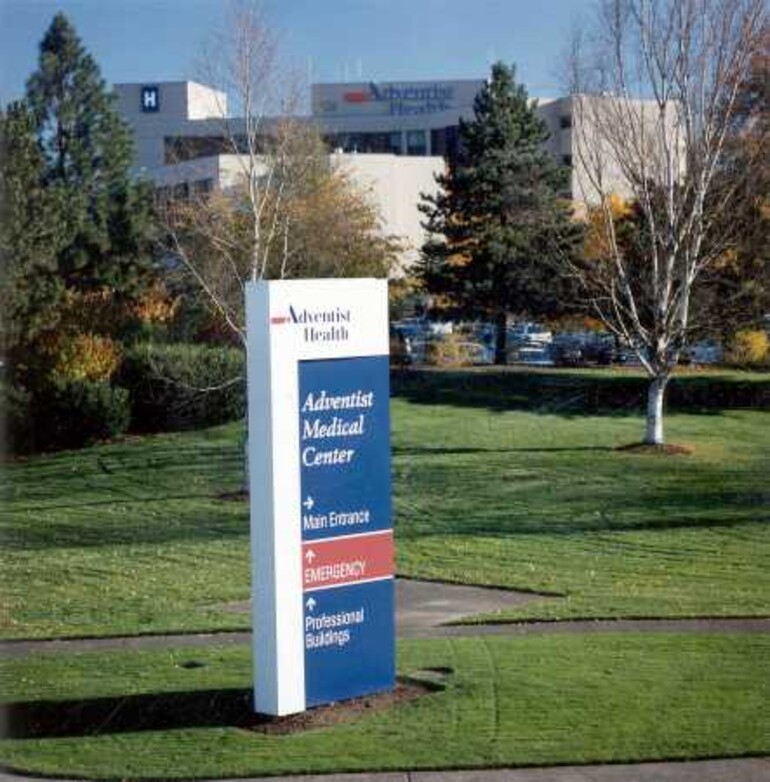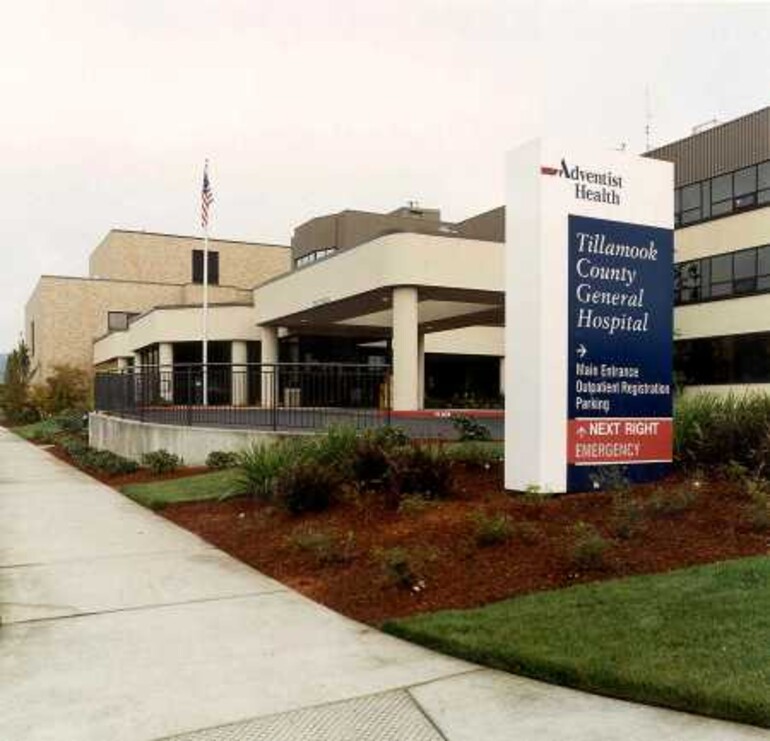A Brand to Remember As you cruise up to the stoplight, a van pulls up beside you. Adventist Health is written across the side along with photos of smiling employees. The light turns green and as you continue on toward the grocery store, you look up and notice a billboard with a young family, proclaiming “Our baby, one hospital: Adventist Health.” Later, as you wait in line at the checkout, you notice an Adventist Medical Center (AMC) logo on the jacket of the guy in front of you. A feeling of déjà vu sweeps over you as you think to yourself, “These people are everywhere!” Experiences such as these are more common than one might think now that the Adventist Health brand is becoming more recognized in the areas it serves. With 20 hospitals in four states, Adventist Health continues to cultivate its brand as a system. In the Portland area alone, Adventist Health is well represented with AMC, 27 off-campus locations and the beginnings of a new, 16,000-square-foot outpatient facility in Gresham, Ore. From on-campus signage and billboards to vehicles and employee uniforms, the brand is everywhere, continuously reinforcing the name of Adventist Health. The other Northwest hospitals, Tillamook County General Hospital and Walla Walla General Hospital, have received similar recognition as their branding efforts begin to pay off as well. Adventist Health Builds a Brand It all began in 1995, when the board of Adventist Health System/West voted to shorten the system’s name to Adventist Health and implement a common branding strategy for all of its hospitals. The goal was to give a clear identity for the system as a whole with direct linkage to Adventist Church sponsorship. “The transition for AMC was easier than most because we already had ‘Adventist’ in our name,” said Monty Knittel, who serves as the Northwest Region’s vice president of marketing. “The Adventist Health brand was a way to position ourselves as a major health care provider on the east side of Portland and tie in all 27 off-campus facilities to the hospital.” The Benefits of Branding The most significant benefit of branding is the single, visual connection it provides among Adventist Health’s services. It links hospitals, physicians’ offices, clinics, home care agencies and more, and customers come to expect a certain level of care throughout the system. The brand reinforcement also promotes other services. For example, if an Adventist Health patient has received excellent care at an area clinic and then later has a need for surgery or hospitalization, he or she will be more apt to use an Adventist Health hospital because of past experience with the brand. Customers are not the only ones who benefit from the single identity. Adventist Health hospitals gain an enormous advantage from the pooling of resources including recruitment tools, such as Adventist Health’s online job application located at www.adventisthealth.org. The branding effort has also enabled the system to streamline marketing and communication efforts in some instances. In addition, joint branding gives hospitals greater leverage in negotiating with vendors and payers. One such example is Project IntelliCare, a new clinical information system that dramatically changes the health care workplace. It allows caregivers to electronically access patient records, lab results, pharmacy support and more. By utilizing the power of technology, Adventist Health hospitals will be able to provide even safer, more effective and efficient care to those they serve. Project IntelliCare was first implemented at AMC and will be rolled out at all system hospitals over the next two to three years. Collaborating with Local Churches An additional benefit of Adventist Health’s brand is its direct tie-in with the Adventist Church. Adventist-affiliated hospitals can help spread the mission of God’s love to their communities, as well as increase interest in and awareness of the church as a whole. This is especially true for smaller communities where the local Adventist church might not be well known. “The Adventist church and Adventist Health have a very valuable relationship, which benefits both entities immensely,” stated Jere Patzer, North Pacific Union Conference president and Adventist Health’s board of directors vice chair. “People in areas with Adventist health care facilities have a higher awareness of the Adventist church and a better idea of its beliefs.” A good example of this is to compare the Portland area to other places that do not have an Adventist Health facility. Portland has a much higher percentage of Adventists and awareness of Adventists, which has been impacted by the presence of AMC. Adventist Health hospitals also tend to bring a strong employee base of Adventists into a community. This, in turn, fosters growth in local Adventist churches as well as bolstering church school attendance. As these different Adventist groups band together in service and outreach, the community at large is blessed. Since the history of the church is largely based in messages of health and wellness, it is only natural that it would be affiliated with health care institutions. Decades before health and exercise fads swept the country, Ellen White was busy teaching principles of healthy living, which ultimately defined the church and its values. Our early hospitals were founded on these teachings. Who knew that at some point all the Adventist Health hospitals on the West Coast would be associated in such a beneficial way? This relationship represents the Adventist Church to many communities that otherwise might never hear its mission. “I am proud of our Adventist heritage, and having its name on our hospital sign gives me an opportunity to share that heritage with others,” stated Knittel.
A Brand to Remember
As you cruise up to the stoplight, a van pulls up beside you. Adventist Health is written across the side along with photos of smiling employees. The light turns green and as you continue on toward the grocery store, you look up and notice a billboard with a young family, proclaiming “Our baby, one hospital: Adventist Health.” Later, as you wait in line at the checkout, you notice an Adventist Medical Center (AMC) logo on the jacket of the guy in front of you. A feeling of déjà vu sweeps over you as you think to yourself, “These people are everywhere!”
Experiences such as these are more common than one might think now that the Adventist Health brand is becoming more recognized in the areas it serves. With 20 hospitals in four states, Adventist Health continues to cultivate its brand as a system.
In the Portland area alone, Adventist Health is well represented with AMC, 27 off-campus locations and the beginnings of a new, 16,000-square-foot outpatient facility in Gresham, Ore. From on-campus signage and billboards to vehicles and employee uniforms, the brand is everywhere, continuously reinforcing the name of Adventist Health. The other Northwest hospitals, Tillamook County General Hospital and Walla Walla General Hospital, have received similar recognition as their branding efforts begin to pay off as well.
Adventist Health Builds a Brand
It all began in 1995, when the board of Adventist Health System/West voted to shorten the system’s name to Adventist Health and implement a common branding strategy for all of its hospitals. The goal was to give a clear identity for the system as a whole with direct linkage to Adventist Church sponsorship.
“The transition for AMC was easier than most because we already had ‘Adventist’ in our name,” said Monty Knittel, who serves as the Northwest Region’s vice president of marketing. “The Adventist Health brand was a way to position ourselves as a major health care provider on the east side of Portland and tie in all 27 off-campus facilities to the hospital.”
The Benefits of Branding
The most significant benefit of branding is the single, visual connection it provides among Adventist Health’s services. It links hospitals, physicians’ offices, clinics, home care agencies and more, and customers come to expect a certain level of care throughout the system.
The brand reinforcement also promotes other services. For example, if an Adventist Health patient has received excellent care at an area clinic and then later has a need for surgery or hospitalization, he or she will be more apt to use an Adventist Health hospital because of past experience with the brand.
Customers are not the only ones who benefit from the single identity. Adventist Health hospitals gain an enormous advantage from the pooling of resources including recruitment tools, such as Adventist Health’s online job application located at www.adventisthealth.org. The branding effort has also enabled the system to streamline marketing and communication efforts in some instances.
In addition, joint branding gives hospitals greater leverage in negotiating with vendors and payers. One such example is Project IntelliCare, a new clinical information system that dramatically changes the health care workplace. It allows caregivers to electronically access patient records, lab results, pharmacy support and more. By utilizing the power of technology, Adventist Health hospitals will be able to provide even safer, more effective and efficient care to those they serve. Project IntelliCare was first implemented at AMC and will be rolled out at all system hospitals over the next two to three years.
Collaborating with Local Churches
An additional benefit of Adventist Health’s brand is its direct tie-in with the Adventist Church. Adventist-affiliated hospitals can help spread the mission of God’s love to their communities, as well as increase interest in and awareness of the church as a whole. This is especially true for smaller communities where the local Adventist church might not be well known.
“The Adventist church and Adventist Health have a very valuable relationship, which benefits both entities immensely,” stated Jere Patzer, North Pacific Union Conference president and Adventist Health’s board of directors vice chair. “People in areas with Adventist health care facilities have a higher awareness of the Adventist church and a better idea of its beliefs.”
A good example of this is to compare the Portland area to other places that do not have an Adventist Health facility. Portland has a much higher percentage of Adventists and awareness of Adventists, which has been impacted by the presence of AMC.
Adventist Health hospitals also tend to bring a strong employee base of Adventists into a community. This, in turn, fosters growth in local Adventist churches as well as bolstering church school attendance. As these different Adventist groups band together in service and outreach, the community at large is blessed.
Since the history of the church is largely based in messages of health and wellness, it is only natural that it would be affiliated with health care institutions. Decades before health and exercise fads swept the country, Ellen White was busy teaching principles of healthy living, which ultimately defined the church and its values. Our early hospitals were founded on these teachings.
Who knew that at some point all the Adventist Health hospitals on the West Coast would be associated in such a beneficial way? This relationship represents the Adventist Church to many communities that otherwise might never hear its mission. “I am proud of our Adventist heritage, and having its name on our hospital sign gives me an opportunity to share that heritage with others,” stated Knittel.












